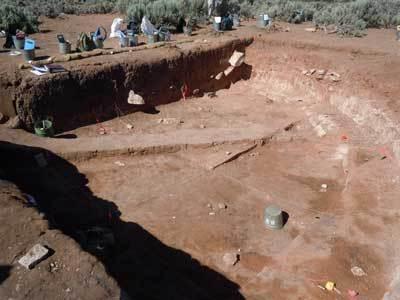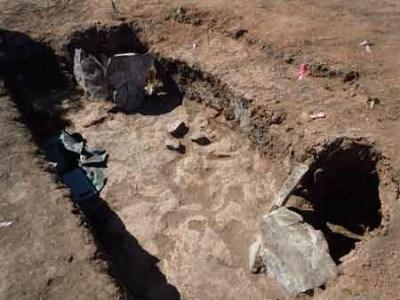Blake De Pastino
Source - http://westerndigs.org/1500-year-old-village-a-sign-of-revolution-in-the-southwest-excavated-in-colorado/
In a high-end housing development north of Cortez, Colorado — just 25 kilometers from the monumental cliffhouses of Mesa Verde National Park — archaeologists have uncovered a cluster of 1,500-year-old houses and a large ceremonial structure that together comprise the earliest known site of its kind in the region.
The settlement includes 10 pithouses built in various styles, situated around a great kiva that likely served as a kind of cultural anchor for a diverse community, the archaeologists say.

Excavations at the Dillard Site near Cortez have revealed a village with a great kiva that predates any other in the region. (Photo © Western Digs)
Based on samples of charcoal and other organic materials, the structures date to around 570 CE — results that are noteworthy not only because of their great age, but because the settlement’s most prominent feature — its great kiva — is the earliest yet found in the area.
“We think we’re at the very first site that has a village forming around public architecture in the central Mesa Verde region,” said Dr. Susan Ryan, Director of Archaeology at the Crow Canyon Archaeological Center, “and that’s unique.”
Crow Canyon staff have been excavating the site, known at the Dillard site, since 2011 under the direction of its supervisory archaeologist, Shanna Diederichs.
Though a long way, both in years and degree, from the grandiose communities at Mesa Verde, the newly discovered village is one of the earliest signs of the social complexity that would become one of the hallmarks of the Ancestral Puebloans.
“What we’re seeing at the Dillard site looks like what we’re seeing later in time as well,” Ryan said.
“This type of social organization set the stage for the next seven centuries. That is one of the most important parts of this project.”
In the sixth century, she pointed out, the central Mesa Verde region — a broad arc of land that runs from the border of northwestern New Mexico to southeastern Utah — was typified by small groups that divided their time between foraging and farming, lived in semi-subterranean houses, and moved frequently.
But the evidence emerging from the high desert here reveals a different picture, Ryan said — that of a full-time, year-round settlement, where people tended crops of corn, beans, and squash and forged a community around a great kiva that was its ritual and political hub.
“This is the first population to move into the central Mesa Verde region and farm and be sedentary full time,” Ryan said.
“And so what we’re interested in is the origins of that population: Are they from the east or the west of the Mesa Verde region? The south?”
While pottery sherds and other artifacts will prove useful in answering these questions, researchers are already seeing clues in the village’s diversity of building styles, she said.
“What’s fascinating about the Dillard site is that not one household there is exactly the same architecturally,” she said.
One newly excavated pithouse, for example, was found to contain two large intact food storage bins made of stone slabs.

Archaeologists describe the diversity of building styles in the village as “fascinating.”
This pithouse, for example, includes two storage bins fashioned from stone slabs, features not found in the other residences. (Photo © Western Digs)
“We don’t have any other excavated structures at the Dillard site that indicate that there’s more than one of those,” Ryan said.
“We have some structures that are round and have no antechamber on them. We’ve got some that are shallow, some that are deep, some that are roofed uniquely.
“So this is providing clues to … not only the actual use of that structure — to see if the form is reflecting function — but also allowing us to look at the architectural patterns that may indicate who these folks are and where they came from.”
Another indicator of the village’s diversity may be its most noteworthy feature: the great kiva.
While the structure itself, 11.5 meters across, is strewn with pottery fragments and other wares that could yield insights into things like stylistic traditions, the real significance of the structure may simply be that it was built when and where it was — decades before any others like it in the region.
Ryan suggested that the kiva’s purpose was to serve as the ritual, political, and social nexus of a newly integrated community.
“Not only is the architecture [of the village] so diverse,” Ryan said, “but why else would you need an integrative public building unless you did have a lot of people from diverse backgrounds who were interested in integrating at the village formation level?”
The fate of the village, among many other questions, remains unclear. But evidence in the kiva indicates that it was ritually burned and abandoned within a hundred years of its construction, Ryan said.

Sherds of grayware and whiteware have been found throughout the site, including these fragments on the floor of the kiva. (Photo © Western Digs)
Crow Canyon staff and volunteers are working to find as many answers as they can during the last season of excavation at the Dillard site.
But Ryan suggested that the entire village itself may be the sign of a crucial social transition that can best be described as revolutionary.
The advent of agriculture — and the sea changes in social organization, cultural practices, and political complexity that attended it — is one of the most important benchmarks that societies have undertaken, Ryan said.
Anthropologists know it as the Neolithic Revolution, when groups pivot from itinerant hunting and gathering to the full-time domestication of crops and animals. And the Dillard site is the earliest evidence yet of this revolution taking place in this part of the pre-Puebloan world.
“The interesting thing to archaeologists is, once people make that jump into agriculture, you can’t go back,” Ryan said. “That is the turning point that we’re locked into forever.
“And I think that’s one of the coolest ways in which we can relate the archaeology of the past to our modern cultures: We’re still locked into this decision that was made by people before us.
“It’s a really intense switch, and human beings can never go back.”